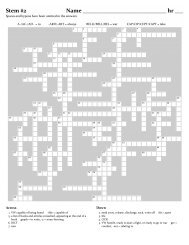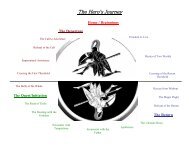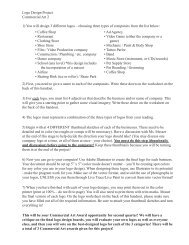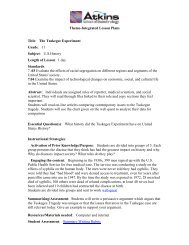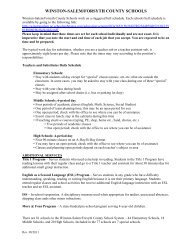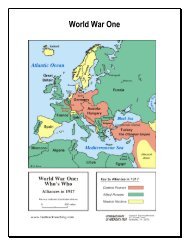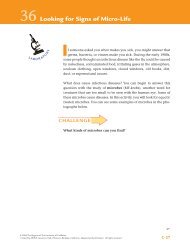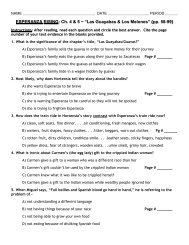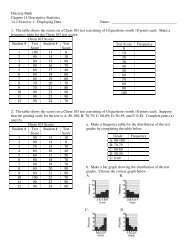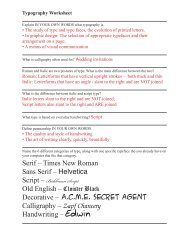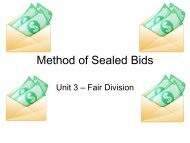You also want an ePaper? Increase the reach of your titles
YUMPU automatically turns print PDFs into web optimized ePapers that Google loves.
Score = 6High schools nowdays are struggling to draw theline between what is “educational” and what is not.School programs are cut based on how mucheducational content they’re perceived to have. Now theadministration is trying to purge the libraries of popularmagazines because they contain non academic subjects.It’s important that the library buy dictionaries andencyclopedias, but education purists need to bereminded that if you separate “academic” from “nonacademic”too strictly, you separate school from the realworld it’s supposed to <strong>prep</strong>are us for.Educators are the ones who tell us we should spendmore time reading. The only way to build the readingcomprehension and vocabulary skills so important forgetting into and through college is to practice, and thatmeans reading things other than school assignments. Noone ever gained reading proficiency from dailystruggles through their Chemistry or History textbooks.We read these because we have to, but we wouldcontinue reading—even during precious homework freemoments—if we had something interesting to turn to.The magazines that teenagers enjoy reading are the onesthat cover our interests and address our concerns, like“Seventeen” or “Teen People”. These are the magazinesthat some would banish from the library.It’s true that not every page in youth magazines isan intellectual challenge. Many pages show modelsselling zit cream, or contain “dream date” quizzes. Butthe critics of popular magazines should take a closerlook at them. These same magazines have articles onsuicide prevention, the spread of AIDS among teens,and college comparisons—subjects that the adultoriented news media doesn’t cover.Even the frivolous features have something to teachthe reader who wants to learn. All those “Great LooksCheap” may be a first step toward becoming a smarterconsumer. The silly quiz may open up questions aboutthe nature of “scientific proof” or lead to more selfknowledge.Learning is where you find it, and students mayfind it in places administrators and librarians might notthink to look. Learning can be found in popularmagazines as well as approved academic texts. Thereshould be room in the school library for both.Score Point 6Scoring ExplanationEssays that earn a score point of 6 demonstrate aclear understanding and effective performance of thepersuasive task. The writer takes a clear position, developsit throughout the essay, and states it directly in theconclusion (Learning can be found in popular magazinesas well as approved academic texts). This position isplaced in a wider context <strong>with</strong>out disrupting the essay’sfocus (High schools nowdays are struggling to draw theline between what is “educational” and what is not.School programs are cut based on how much educationalcontent they’re perceived to have).The essay addresses complexity by anticipatingcounterarguments to the writer’s position (It’s true thatnot every page in youth magazines is an intellectualchallenge) and fully responding to those counterargumentsby showing specifically where they are weak(These same magazines have articles on suicide prevention,the spread of AIDS among teens, and collegecomparisons—subjects that the adult oriented newsmedia doesn’t cover).The writer’s ideas may not be developed evenlyover all the paragraphs, but their development is succinctand logical. The essay elaborates general statements(Even the frivolous features have something toteach the reader who wants to learn) by moving to morespecific details and examples (All those “Great LooksCheap” may be a first step toward becoming a smarterconsumer).The organization of the essay is clear and the logicalsequence of ideas grows out of the writer’s intent topersuade. Transitions help the essay flow smoothly fromone paragraph to the next (It’s true that not every pagein youth magazines is an intellectual challenge.... Eventhe frivolous features have something to teach thereader who wants to learn). The introduction is clear andespecially well developed, connecting the writer’s positionto a strong critical claim (if you separate “academic”from “non-academic” too strictly, you separate schoolfrom the real world it’s supposed to <strong>prep</strong>are us for).This essay shows a good command of language.Word choice is precise and persuasive (purge thelibraries, frivolous features). Facility <strong>with</strong> words and sentencestructure enables the writer to maintain a light,amused tone (The silly quiz may open up questionsabout the nature of “scientific proof” or lead to more selfknowledge).There are few errors in this essay, and theyscarcely distract the reader.71



